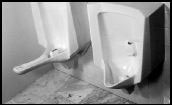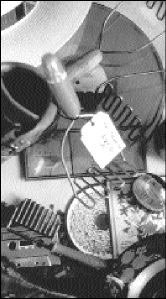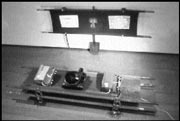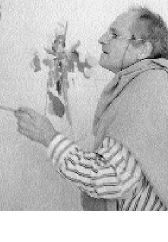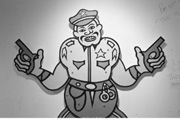ALEXANDER SCHWEDER “ABJECTECTURE” AND SARAH PETERS “PINK DINGUS”
Esther Claypool Gallery, 617 Western, 264-1586, 11 a.m. -6 p.m. Tues.-Fri.; 11 a.m. -5 p.m. Sat.; reception: 6-8 p.m. Thurs. Oct. 4; gallery talk with Schweder: 7 p.m. Thurs. Oct. 25 ends Oct. 27
DID YOU INDULGE in the pleasure of urination today? Of course you did. But chances are pretty good you didn’t stop to ponder the poetry of the act. And there’s no way in hell you deemed that necessary bodily procedure to be art. Peeing is a mundane operation we’ve made as antiseptic and insignificant as possible. Not only that, the functions of the mortal coil—especially those that produce any kind of waste or fluid—are embarrassing occurrences that we hide fastidiously. Asking himself, “How can I make people have a fantastic experience with their pee?” artist Alexander Schweder decided to change all that. Schweder seeks to repackage peeing with all the importance and gravity we grant to culturally ritualized activities like eating or bathing—arguably equally quotidian and corporeal. His Peescapes are urinals for men and women specially designed to make pee into art and peeing into poetry.
Schweder is certainly not the first artist to employ piss as a medium. A long line of conceptualists before him exploited urine’s degradative qualities to defame sacred objects, to symbolize the corporeal at its most base, or for sheer shock value. Schweder, by contrast, is dead serious about elevating the routine act of urination to something more sensual and casting pee in a thoroughly positive light. He crafted his work during an artist residency at the John Michael Kohler Arts Center in Sheboygan, Wis., where he had unlimited access to the bathroom fixture giant’s entire production—porcelain, plaster, sinks, ironworks, faucets, and, yes, urinals. The Kohler Arts Center hosts nearly 20 residencies a year, but Schweder is one of the only artists to modify Kohler’s own products for his projects.
Men, who’ve had the luxury of facing off with urinals (or with trees, or dirt), pointing their stream of pee, and watching it flow, are perhaps more ready to take the leap to pee as art. But Schweder’s urinals don’t leave women out. His fully functional urinal “diptychs” pair a more standard-shaped male urinal with a version designed for a woman to use. The women’s models, strangely phallic, are to be straddled, offering women the fine experience of watching the pee flow. The art is in the movement—or choreography, if you will—of piss. Schweder manipulates this movement by crafting channels and protrusions, dams and drains in the seamless porcelain of each bowl. The result: interactive fountains, utilitarian sculpture, and, most importantly, a moment to reflect on the poetry of bodily and architectural function.
But don’t arrive at the gallery with a full bladder ready to take a leak. Due to current gallery propriety and standing cultural conventions—not to mention lack of proper plumbing—the urinals on view can’t be experienced to their fullest extent. In lieu of a peeing free-for-all, Schweder documents the effect of urine traveling through his creations photographically. The rest is left up to our imaginations.
THERE’S NO question that urinals on display instantly call Dadaist prankster Marcel Duchamp to mind. However, while Schweder is perhaps winking in tribute to the unlimited possibilities that Duchamp unleashed nearly a century ago, his Peescape urinals really have little to do with found art (unless you consider the pee itself to be the discovery here) and even less to do with art history. Schweder, schooled as an architect at Pratt Institute and then Princeton, is more interested in minimizing or eliminating the distinction between the body and buildings. As he puts it, his works in “Abjectecture” “sensualize the experience of allowing your body to become the building.” The urinal represents the threshold between body and building and also the point where the two intersect, become one. Schweder argues that we sublimate in equal measure the ideas that our bodies and the buildings in which we dwell are messy, leaky, waste-producing.
To further illustrate this point, Schweder has fabricated porcelain models of leaky buildings—namely, car washes that ooze water, motor oil, antifreeze, and windshield fluid. It turns out that abject fluids from automobiles in various combinations make luscious colors. Schweder presents these in photographic color studies that recall the canvases of Mark Rothko. X-ray photographs of the carwash model make even more explicit the similarities between body and building.
Schweder’s sculptural essays on abject fluids are presented alongside Sarah Peters’ installation, “Pink Dingus.” Peters, who has also been an artist in residence at Kohler, is fascinated with a different form of the abject. Her richly detailed objects reflect the cast-off trappings of girlhood. As she explains, “dingus is a gadget or other article whose name is unknown or forgotten.” Her objects, fabricated from cast iron, glass, porcelain, and found articles, conjure the personal icons that a girl must reject as she passes into womanhood: horses, ribbons, flowers, hair. But, rather than re-creating the soft, tattered, ephemeral detritus obsessively stored in a girl’s jewelry box, Peters fashions hard, cold, stiff memorials for what was once warm, soft, and beloved. What remains constant in these objects is the delightful chaos and intense memories that they represent. Both artists glory in what is cast off, memorializing, if just for a fleeting moment, what is so easily forgotten forever.
